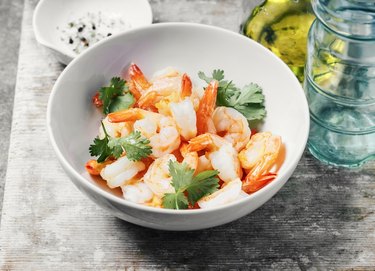
Potassium is an essential nutrient your body needs to regulate its heartbeat, muscle contractions and fluid balance. If your kidneys aren't working properly, you may have been advised to follow a low-potassium diet menu.
You may be wondering what types of foods you can and cannot eat on your low-potassium diet. In general, meat and fish aren't considered high-potassium foods. For individualized guidance and expert care, consult with a registered dietitian.
Video of the Day
Video of the Day
Potassium and Your Health
Without enough potassium, your body can't work properly. Potassium is a mineral and an electrolyte that helps maintain fluid balance, moves nutrients in and out of cells and assists in the proper functioning of your heartbeat, muscles and nerves.
According to the Office of Dietary Supplements, the adequate intake for potassium ranges from 2,400 to 3,600 milligrams a day depending on age and sex. Adequate intake means the amount needed to meet nutritional needs without leading to a deficiency. However, because higher intakes of potassium help lower blood pressure by blunting the effects of sodium, the American Heart Association recommends adults aim for 4,700 milligrams a day.
While potassium is essential for good health, if you have kidney disease, you may be advised to limit your intake. Your kidneys are responsible for maintaining potassium balance in your blood. If your blood potassium levels get too high, referred to as hyperkalemia, then you may experience weakness or numbness. Hyperkalemia can also lead to an irregular heartbeat or even a heart attack.
According to the National Kidney Foundation, if you have kidney disease or you've been prescribed a renal diet by your doctor, then you need to limit your daily intake of potassium to 2,000 milligrams a day.
Foods High in Potassium
When you've been prescribed a low-potassium diet menu, it's important to understand what foods are high in potassium so you can omit or limit them. As a general rule of thumb, the National Kidney Foundation says that any food with more than 200 milligrams of potassium per serving would be considered a high-potassium food.
Fruits and vegetables are the primary sources of potassium in the diet. Foods high in potassium include:
- Bananas
- Apricots
- Avocados
- Oranges
- Potatoes
- Leafy greens
- Carrots
- Pumpkin
- Tomatoes
- Rutabaga
The National Kidney Foundation also notes that legumes, yogurt, nuts, seeds and salt substitutes are also high-potassium foods that should be consumed in limited quantities if you're on a low-potassium diet.
You may be able to leach out some of the potassium in certain high-potassium vegetables — potatoes, carrots, rutabagas — by soaking them in warm water for at least two hours. Then, drain your soaked vegetables, rinse under running warm water and cook in a large pot of boiling water. Be sure to discard all of the cooking water.
Low-Potassium Meats and Fish
While meat and fish are a source of potassium, according to the National Kidney Foundation, they're not considered high-potassium foods. However, the amount of potassium may vary depending on the type of meat or fish. When following a low-potassium diet menu, include more fresh meat and fish, as opposed to processed meats and fish, such as deli meats, fried meats or fish, breaded fish or meat or fish covered in heavy sauces.
According to the USDA, the potassium in beef products in a 100-gram portion includes:
- Braised pork chops: 270 milligrams
- Corned beef brisket: 145 milligrams
- Cooked bottom round roast: 210 milligrams
- Cooked chuck, rib or loin: 99 milligrams
- Cooked lamb shoulder, rib or roast: 82 milligrams
- Cooked veal chops, tenderloin or roast: 173 milligrams
According to the USDA, the potassium in fish varieties in a 100-gram portion includes:
- Cooked shrimp: 259 milligrams
- Cooked Atlantic cod: 244 milligrams
- Cooked flounder or sole: 197 milligrams
- Light tuna, canned in water: 179 milligrams
- Smoked Chinook salmon: 175 milligrams
For comparison, potassium in chicken breast stewed without the skin (100-gram portion) is 258 milligrams.
A low-potassium diet menu requires some planning. To help you stay within an acceptable range, it's recommended that you talk to a registered dietitian for guidance. In addition to limiting your intake of high-potassium fruits and vegetables, you may also need to limit the amount of meat, fish and chicken you consume in a day. The Dietitians of Canada suggest no more than 5 ounces of meat, fish or chicken a day when following a low-potassium diet menu.
However, if you're on dialysis, you may need to eat more of these protein-rich foods while still limiting your potassium intake. Dialysis is a medical treatment that clears your blood of fluid and waste after kidney failure. The treatment is considered catabolic, meaning it burns through your energy stores. Higher protein intakes are recommended when receiving dialysis to prevent malnutrition.
- Office of Dietary Supplements: "Potassium"
- American Heart Association: "A Primer on Potassium"
- National Kidney Foundation: "Potassium and Your CKD Diet"
- National Kidney Foundation: "What Meats and Fish Are Low in Potassium?"
- USDA Food Nutrient Database: Nutrient List: "Potassium, Lamb, Veal, and Game Products"
- USDA Food Nutrient Database: Nutrient List: "Potassium: Beef Products"
- USDA Food Nutrient Database: Nutrient List: "Potassium: Pork Products"
- USDA Food Nutrient Database: Nutrient List: "Potassium: Finfish and Shellfish Products"
- USDA FoodData Central: "Chicken, Breast, Stewed, Skin Not Eaten"
- Dietitians of Canada: "Eating Well on a Low Potassium Diet"
- National Institute of Diabetes and Digestive and Kidney Diseases: "Eating and Nutrition for Hemodialysis"